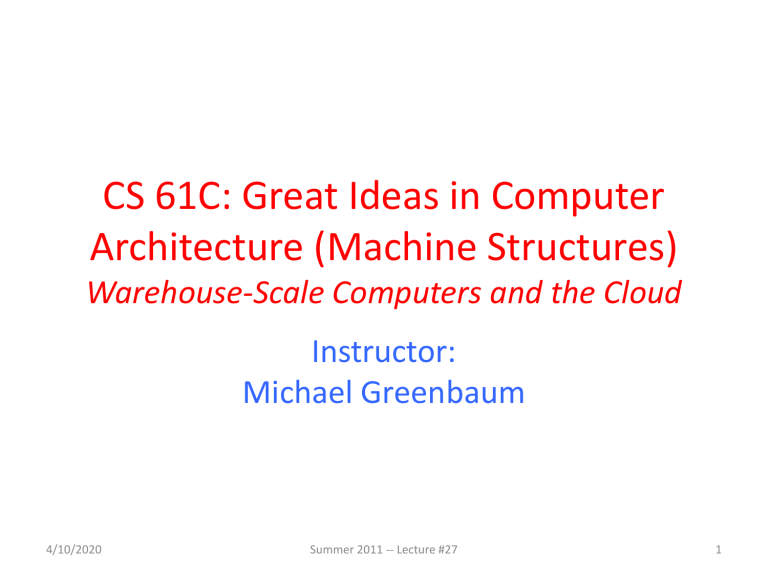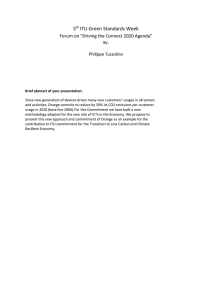CS 61C: Great Ideas in Computer Architecture (Machine Structures) Instructor:

4/10/2020
CS 61C: Great Ideas in Computer
Architecture (Machine Structures)
Warehouse-Scale Computers and the Cloud
Instructor:
Michael Greenbaum
Summer 2011 -- Lecture #27 1
New-School Machine Structures
(It’s a bit more complicated!)
•
Today’s Lecture
Software Hardware
• Parallel Requests
Assigned to computer e.g., Search “Katz”
Warehouse
Scale
Computer
Parallel Threads
Harness
Parallelism &
Assigned to core
Achieve High e.g., Lookup, Ads Performance
Computer
• Parallel Instructions Core … Core
>1 instruction @ one time e.g., 5 pipelined instructions
• Parallel Data
>1 data item @ one time e.g., Add of 4 pairs of words
• Hardware descriptions
All gates @ one time
Memory (Cache)
Input/Output
Instruction Unit(s)
A
0
+B
0
A
1
+B
1
A
2
+B
2
A
3
+B
3
Main Memory
Core
Functional
Unit(s)
Smart
Phone
Logic Gates
4/10/2020 Summer 2011 -- Lecture #27 2
Google’s Oregon
Warehouse-Scale Computer
4/10/2020 Summer 2011 -- Lecture #9 3
One Million Servers:
400 Containers x 2500 Nodes
4
Agenda
• Cloud Computing
• Administrivia
• Warehouse Scale Computers
• Break
• Power Usage Effectiveness
• WSC Costs
• Request Level Parallelism (If time)
4/10/2020 Summer 2011 -- Lecture #27 5
The Big Switch: Utility Computing
“A hundred years ago, companies stopped generating their own power with steam engines and dynamos and plugged into the newly built electric grid. The cheap power pumped out by electric utilities didn’t just change how businesses operate. It set off a chain reaction of economic and social transformations that brought the modern world into existence. Today, a similar revolution is under way. Hooked up to the Internet’s global computing grid, massive information-processing plants have begun pumping data and software code into our homes and businesses. This time, it’s computing that’s turning into a utility.”
Fall 2010 -- Lecture #8 6 4/10/2020
Cloud Computing
“Delivery of computer services from vast warehouses of shared machines —enables cutting of costs by handing over the running of applications and services to a third party, then accessed over the internet. There are advantages for customers (lower cost, less complexity) and service providers (economies of scale). But customers risk losing control, in particular over their data, as they migrate into the cloud. Moving from one service provider to another could be even more difficult than switching between software packages in the old days.”—The Economist, May 28, 2009
4/10/2020 Summer 2011 -- Lecture #27 7
Cloud Services
• SaaS : deliver apps over Internet, eliminating need to install/run on customer's computers, simplifying maintenance and support
– E.g., Google Docs, Win Apps in the Cloud
• PaaS : deliver computing “stack” as a service, using cloud infrastructure to implement apps.
Deploy apps without cost/complexity of buying and managing underlying layers
– E.g., Hadoop on EC2, Google App Engine
• IaaS : Rather than purchasing servers, sw, DC space or net equipment, clients buy resources as an outsourced service. Billed on utility basis. Amount of resources consumed/cost reflect level of activity
– E.g., EC2
4/10/2020 Summer 2011 -- Lecture #27 8
Alternate Service Stacks
4/10/2020 Summer 2011 -- Lecture #27 9
Cloud Distinguished by …
• Shared platform with illusion of isolation
– Collocation with other tenants
– Exploits technology of VMs and hypervisors
– At best “fair” allocation of resources, but not true isolation
• Attraction of low-cost cycles
– Economies of scale driving move to consolidation
– Multiplexing of resources to achieve high utilization/efficiency
• Elastic service
− Pay for what you need, get more when you need it
− But no performance guarantees: assumes uncorrelated demand for resources
− Amazon EC2 - Elastic Compute Cluster.
4/10/2020 Summer 2011 -- Lecture #27 10
Economics For Cloud Users
• Pay by use instead of provisioning for peak
4/10/2020
Capacity
Time
Static data center
Demand
Capacity
Time
Data center in the cloud
Demand
Unused resources
Summer 2011 -- Lecture #27 11
Economics For Cloud Users
• Risk of over-provisioning: underutilization
Capacity
Unused resources
Demand
Time
Static data center
4/10/2020 Summer 2011 -- Lecture #27 12
Economics For Cloud Users
• Heavy penalty for under-provisioning
Capacity
3
Demand
Summer 2011 -- Lecture #27
1 2
Time (days)
Lost revenue
Capacity
3
Demand
1
Time (days)
2
Lost users
Capacity
3
Demand
13 4/10/2020
1
Time (days)
2
Scale Economics For Cloud Providers
• 5-7x economies of scale
Resource
Cost in
Medium DC
Cost in
Very Large DC
$95 / Mbps / month $13 / Mbps / month
Ratio
Network 7.1x
Storage $2.20 / GB / month $0.40 / GB / month 5.7x
Administration ≈140 servers/admin >1000 servers/admin 7.1x
• Extra benefits
– Amazon: utilize off-peak capacity
– Microsoft: sell .NET tools
– Google: reuse existing infrastructure
4/10/2020 Summer 2011 -- Lecture #27 14
Agenda
• Cloud Computing
• Administrivia
• Warehouse Scale Computers
• Power Usage Effectiveness
• WSC Costs
• Request Level Parallelism (If time)
4/10/2020 Summer 2011 -- Lecture #27 15
Warehouse Scale Computers
• Massive scale datacenters: 10,000 to 100,000 servers + networks to connect them together
• Very highly available: <1 hour down/year
– Must cope with failures common at scale
• Differ from classic Datacenter because of:
– Homogeneous hardware/software, infrastructure
– Offer small number of very large applications
(Internet services): search, social networking, video sharing
4/10/2020 Summer 2011 -- Lecture #27 16
Equipment Inside a WSC
Server (in rack format):
1 ¾ inches high “1U”, x 19 inches x 16-20 inches: 8 cores, 16 GB
Array (aka cluster):
16-32 server racks +
DRAM, 4x1 TB disk
7 foot Rack : 40-80 servers + Ethernet local area network (1-10 Gbps) switch in middle (“rack switch”)
4/10/2020 Summer 2011 -- Lecture #27 larger local area network switch (“array switch”)
17
Server, Rack, Array
4/10/2020 Summer 2011 -- Lecture #27 18
Google Server
Google Server Internals
4/10/2020 Summer 2011 -- Lecture #27 19
Processing Infrastructure
4/10/2020 Fall 2010 -- Lecture #8 20
Coping with Performance in Array
Lower latency to DRAM in another server than local disk
Higher bandwidth to local disk than to DRAM in another server
Local Rack Array
Racks
Servers
--
1
1
80
30
2400
Cores (Processors) 8 640 19,200
DRAM Capacity (GB)
Disk Capacity (GB)
16 1,280 38,400
4,000 320,000 9,600,000
DRAM Latency (microseconds) 0.1
100 300
Disk Latency (microseconds) 10,000 11,000 12,000
DRAM Bandwidth (MB/sec) 20,000 100 10
200 100
Coping with Workload Variation
2X
Midnight Noon Midnight
• Online service: Peak usage 2X off-peak
4/10/2020 Summer 2011 -- Lecture #27 22
Impact of latency, bandwidth, failure, varying workload on WSC software?
• WSC Software must take care where it places data within an Array to get good performance
• WSC Software must cope with failures gracefully
• WSC Software must scale up and down gracefully in response to varying demand
• More elaborate hierarchy of memories, failure tolerance, workload accommodation makes
WSC software development more challenging than software for single computer
4/10/2020 Summer 2011 -- Lecture #27 23
Administrivia
• No lab today- Work on project, study for final, etc.
TAs will be there.
– Lab 12 due during this lab!
• Sign up for project 3 face-to-face grading.
– In 200 SD, Wednesday, 8/10.
• Final Review - Monday, 8/8, 4pm-6pm, 277 Cory.
• Final Exam - Thursday, 8/11, 9am - 12pm 2050 VLSB
– Two-sided handwritten cheat sheet. Green sheet provided.
• Use the back side of your midterm cheat sheet!
4/10/2020 Summer 2011 -- Lecture #24 24
Agenda
• Cloud Computing
• Administrivia
• Power Usage / Efficiency
• Break
• Power Usage Effectiveness
• WSC Costs
• Request Level Parallelism (If time)
4/10/2020 Summer 2011 -- Lecture #27 25
Emphasis on Cost Efficiency
• WSCs must scale to increasing customer demand, increasing complexity of problems to solve.
• More computing power usually => better product.
• Focus on cost efficiency to afford as much computation as possible.
– Power consumption is a dominant cost.
4/10/2020 Summer 2011 -- Lecture #27 26
Energy Proportional Computing
“The Case for
Energy-Proportional
Computing,”
Luiz André Barroso,
Urs Hölzle,
IEEE Computer
December 2007
It is surprisingly hard to achieve high levels of utilization of typical servers (and your home
PC or laptop is even worse)
Figure 1. Average CPU utilization of more than 5,000 servers during a six-month period. Servers most of the time at between 10 and 50 percent of their maximum
27
Energy Proportional Computing
“The Case for
Energy-Proportional
Computing,”
Luiz André Barroso,
Urs Hölzle,
IEEE Computer
December 2007
Doing nothing well …
NOT!
Energy Efficiency =
Utilization/Power
4/10/2020
Figure 2. Server power usage and energy efficiency at varying utilization levels, from idle to peak performance. Even an energy-efficient server still consumes about half its full power when doing virtually no work.
Fall 2010 -- Lecture #8 28
Energy Proportional Computing
“The Case for
Energy-Proportional
Computing,”
Luiz André Barroso,
Urs Hölzle,
IEEE Computer
December 2007
Doing nothing
VERY well
Design for wide dynamic
power range and active low power modes
Energy Efficiency =
Utilization/Power
4/10/2020
Figure 4. Power usage and energy efficiency in a more energy-proportional server. This server has a power efficiency of more than 80 percent of its peak value for utilizations of
30 percent and above, with efficiency remaining above 50 percent for utilization levels as low as 10 percent.
Fall 2010 -- Lecture #8 29
Server Power Consumption
4/10/2020
Peak
Power %
Summer 2011 -- Lecture #27 30
Power vs. Server Utilization by
Component
4/10/2020 Summer 2011 -- Lecture #27 31
Agenda
• Cloud Computing
• Administrivia
• Warehouse Scale Computers
• Break
• Power Usage Effectiveness
• WSC Costs
• Request Level Parallelism (If time)
4/10/2020 Summer 2011 -- Lecture #27 32
Agenda
• Cloud Computing
• Administrivia
• Warehouse Scale Computers
• Break
• Power Usage Effectiveness
• WSC Costs
• Request Level Parallelism (If time)
4/10/2020 Summer 2011 -- Lecture #27 33
Power Usage Effectiveness
• Overall WSC Energy Efficiency: amount of computational work performed divided by the total energy used in the process
• Power Usage Effectiveness (PUE):
Total building power / IT equipment power
– An power efficiency measure for WSC, not including efficiency of servers, networking gear
– 1.0 => perfection
– e.g. 2.0 => half of WSC energy spent on infrastructure overhead.
4/10/2020 Summer 2011 -- Lecture #27 34
PUE in the Wild (2007)
4/10/2020 Summer 2011 -- Lecture #27 35
High PUE: Where Does Power Go?
Uninterruptable
Power Supply
(battery)
Chiller cools warm water from Air
Conditioner
Power
Distribution
Unit
Servers +
Networking
Computer
Room
Air
4/10/2020 Summer 2011 -- Lecture #27
DC Infrastructure Energy Efficiencies
Cooling (Air + Water movement) + Power Distribution
4/10/2020 Fall 2010 -- Lecture #8 37
Google WSC A PUE: 1.24
1. Careful air flow handling
• Don’t mix server hot air exhaust with cold air
(separate warm aisle from cold aisle)
• Short path to cooling so little energy spent moving cold or hot air long distances
• Keeping servers inside containers helps control air flow
4/10/2020 Summer 2011 -- Lecture #27 38
Containers in WSCs
Inside WSC
Inside Container
4/10/2020 Summer 2011 -- Lecture #27 39
Google WSC A PUE: 1.24
2. Elevated cold aisle temperatures
• 81°F instead of traditional 65°- 68°F
• Found reliability OK if run servers hotter
3. Use of free cooling
• Cool warm water outside by evaporation in cooling towers
• Locate WSC in moderate climate so not too hot or too cold
4/10/2020 Summer 2011 -- Lecture #27 40
Google WSC A PUE: 1.24
4. Per-server 12-V DC UPS
• Rather than WSC wide UPS, place single battery per server board
• Increases WSC efficiency from 90% to 99%
5. Measure vs. estimate PUE, publish PUE, and improve operation
4/10/2020 Summer 2011 -- Lecture #27 41
Google WSC PUE: Quarterly Avg
PUE
• www.google.com/corporate/green/datacenters/measuring.htm
4/10/2020 Summer 2011 -- Lecture #27 42
Agenda
• Cloud Computing
• Administrivia
• Warehouse Scale Computers
• Break
• Power Usage Effectiveness
• WSC Costs
• Request Level Parallelism (If time)
4/10/2020 Summer 2011 -- Lecture #27 43
Design Goals of a WSC
• Unique to Warehouse-scale
– Ample parallelism:
• Lots of independent requests. Request-Level Parallelism
• Large data sets with processing that can be done on each element independently. Data-Level Parallelism
– Scale and its Opportunities/Problems
• Price breaks are possible from purchases of very large numbers of commodity servers
• Must also prepare for high component failures
– Operational Costs Count:
• Cost of equipment purchases << cost of ownership
4/10/2020 Summer 2011 -- Lecture #27 44
WSC Case Study
Server Provisioning
WSC Power Capacity
Power Usage Effectiveness (PUE) 1.50
8.00 MW
IT Equipment Power Share
Power/Cooling Infrastructure
0.67
5.36 MW
0.33
2.64 MW
IT Equipment Measured Peak (W) 145.00
Assume Average Pwr @ 0.8 Peak 116.00
# of Servers
# of Servers per Rack
# of Racks
Top of Rack Switches
# of TOR Switch per L2 Switch
# of L2 Switches
# of L2 Switches per L3 Switch
# of L3 Switches
40.00
46000
1150
1150
16.00
72
24.00
3
Internet
L3 Switch
L2 Switch
…
TOR Switch
Rack …
Server
4/10/2020 Summer 2011 -- Lecture #27 45
WSC Case Study
Capital Expenditure (Capex)
• Facility cost and total IT cost about the same
Facility Cost
Total Server Cost
TOR Switch Cost
L2 Switch Cost
L3 Switch Cost
Total Network Cost
Total Cost
$88,000,000
$1,450 $66,700,000
$1,400 $1,610,000
$140,000 $10,080,000
$280,000 $840,000
$12,530,000
$167,230,000
4/10/2020 Summer 2011 -- Lecture #27 46
Cost of WSC
• US account practice allow converting Capital
Expenditure (CAPEX) into Operational
Expenditure (OPEX) by amortizing costs over time period
– Servers 3 years
– Networking gear 4 years
– Facility 10 years
4/10/2020 Summer 2011 -- Lecture #2 47
WSC Case Study
Operational Expense (Opex)
Years
Monthly Cost
Amortization
Amortized
Capital
Expense
Operational
Expense
Server
Network
Facility
Pwr&Cooling
Other
Amortized Cost
Power (8MW)
People (3)
Total Monthly
$/kWh
3 $66,700,000
4 $12,530,000
$88,000,000
10 $72,160,000
10 $15,840,000
$0.07
$2,000,000 55%
$295,000 8%
$625,000 17%
$140,000 4%
$3,060,000
$475,000 13%
$85,000 2%
$3,620,000 100%
• Monthly Power costs
• $475k for electricity
• $625k + $140k to amortize facility power distribution and cooling
4/10/2020 Fall 2010 -- Lecture #37 48
How much does a watt cost in a WSC?
• 8 MW facility
• Amortized facility, including power distribution and cooling is $625k + $140k =
$765k
• Monthly Power Usage = $475k
• $/Year = ($765k+$475k)*12/8M = $1.86 or about $2 per year
• To save a watt, if spend more than $2 a year, lose money
4/10/2020 Summer 2011 -- Lecture #2 49
Replace Rotating Disks with Flash?
• Flash is non-volatile semiconductor memory
– Costs about $20 / GB, Capacity about 10 GB
– Power about 0.01 Watts
• Disk is non-volatile rotating storage
– Costs about $0.1 / GB, Capacity about 1000 GB
– Power about 10 Watts
• Should replace Disk with Flash to save money?
A red) No: Capex Costs are 100:1 of OpEx savings!
B orange) Don’t have enough information to answer question
C green) Yes: Return investment in a single year!
4/10/2020 Summer 2011 -- Lecture #2 50
Replace Rotating Disks with Flash?
• Flash is non-volatile semiconductor memory
– Costs about $20 / GB, Capacity about 10 GB
– Power about 0.01 Watts
• Disk is non-volatile rotating storage
– Costs about $0.1 / GB, Capacity about 1000 GB
– Power about 10 Watts
• Should replace Disk with Flash to save money?
A red) No: Capex Costs are 100:1 of OpEx savings!
B orange) Don’t have enough information to answer question
C green) Yes: Return investment in a single year!
4/10/2020 Summer 2011 -- Lecture #2 51
WSC Case Study
Operational Expense (Opex)
Years
Monthly Cost
Amortization
Amortized
Capital
Expense
Operational
Expense
Server
Network
Facility
Pwr&Cooling
Other
Amortized Cost
Power (8MW)
People (3)
Total Monthly
$/kWh
3 $66,700,000
4 $12,530,000
$88,000,000
10 $72,160,000
10 $15,840,000
$0.07
$2,000,000 55%
$295,000 8%
$625,000 17%
$140,000 4%
$3,060,000
$475,000 13%
$85,000 2%
$3,620,000 100%
• $3.8M/46000 servers = ~$80 per month per server in revenue to break even
• ~$80/720 hours per month = $0.11 per hour
• So how does Amazon EC2 make money???
4/10/2020 Fall 2010 -- Lecture #37 52
January 2011 AWS Instances & Prices
Instance
Standard Small
Standard Large
Standard Extra Large
High-Memory Extra Large
High-Memory Double Extra Large
High-Memory Quadruple Extra Large
High-CPU Medium
High-CPU Extra Large
Cluster Quadruple Extra Large
Per
Hour
$0.085
$0.340
$0.680
$0.500
$1.000
$2.000
$0.170
$0.680
$1.600
Ratio to
Small
Compute
Units
Virtual
Cores
Compute
Unit/
Core
Memory
(GB)
1.0
4.0
8.0
5.9
11.8
23.5
2.0
8.0
18.8
1.0
4.0
8.0
6.5
13.0
26.0
5.0
20.0
33.5
Disk
(GB) Address
1 1.00
2 2.00
1.7
160 32 bit
7.5
850 64 bit
4 2.00
15.0 1690 64 bit
2 3.25
17.1
420 64 bit
4 3.25
34.2
850 64 bit
8 3.25
68.4 1690 64 bit
2 2.50
8 2.50
1.7
350 32 bit
7.0 1690 64 bit
8 4.20
23.0
1690 64 bit
• Closest computer in WSC example is Standard Extra Large
• @$0.11/hr, Amazon EC2 can make money!
– even if used only 50% of time
4/10/2020 Fall 2010 -- Lecture #37 53
Agenda
• Cloud Computing
• Administrivia
• Warehouse Scale Computers
• Break
• Power Usage Effectiveness
• WSC Costs
• Request Level Parallelism
4/10/2020 Summer 2011 -- Lecture #27 54
Request-Level Parallelism (RLP)
• Hundreds or thousands of requests per second
– Internet services like Google search
– Such requests are largely independent
• Mostly involve read-only databases
• Little read-write (aka “producer-consumer”) sharing
• Rarely involve read–write data sharing or synchronization across requests
• Computation easily partitioned within a request and across different requests
4/10/2020 Summer 2011 -- Lecture #2 55
Google Query-Serving Architecture
4/10/2020 Summer 2011 -- Lecture #2 56
Anatomy of a Web Search
• Google “Randy H. Katz”
– Direct request to “closest” Google Warehouse Scale
Computer
– Front-end load balancer directs request to one of many arrays (cluster of servers) within WSC
– Within array, select one of many Google Web Servers
(GWS) to handle the request and compose the response pages
– GWS communicates with Index Servers to find documents that contain the search words, “Randy”,
“Katz”, uses location of search as well
– Return document list with associated relevance score
4/10/2020 Summer 2011 -- Lecture #2 57
Anatomy of a Web Search
• In parallel,
– Ad system: books by Katz at Amazon.com
– Images of Randy Katz
• Use docids (document IDs) to access indexed documents
• Compose the page
– Result document extracts (with keyword in context) ordered by relevance score
– Sponsored links (along the top) and advertisements
(along the sides)
4/10/2020 Summer 2011 -- Lecture #2 58
4/10/2020 Summer 2011 -- Lecture #2 59
Anatomy of a Web Search
• Implementation strategy
– Randomly distribute the entries
– Make many copies of data (aka “replicas”)
– Load balance requests across replicas
• Redundant copies of indices and documents
– Breaks up hot spots, e.g., “Justin Bieber”
– Increases opportunities for request-level parallelism
– Makes the system more tolerant of failures
4/10/2020 Summer 2011 -- Lecture #2 60
Summary
• Cloud Computing
– Benefits of WSC computing for third parties
– “Elastic” pay as you go resource allocation
– Amazon demonstrates that you can make money by selling cycles and storage
• Warehouse-Scale Computers (WSCs)
– Power ultra large-scale Internet applications
– Emphasis on cost, power efficiency
– PUE - Ratio of total power consumed over power used for computing.
4/10/2020 Summer 2011 -- Lecture #27 61






